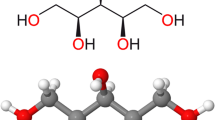Abstract
Oral cryotherapy causes local vasoconstriction, which reduces blood flow and reduces the cytotoxic damage to the oral mucosa, has been shown to reduce oral mucositis after intense cytostatic treatment. The main object of this study was to investigate the effect of oral cryotherapy on the temperature in the oral mucosa, the level of proinflammatory cytokine interleukin-6 (IL-6) in saliva and the effect on blood pressure in healthy volunteers, before and after 1 h of cooling the oral cavity with crushed ice. Twelve healthy volunteers [mean age 32.4 (SD 13.2) (20–56) years] were treated with oral cryotherapy in the form of crushed ice. Temperature measurements were performed in the oral mucosa using infrared thermograph following a flowchart protocol. Blood pressure (BP) was measured with a sphygmomanometer. Saliva was analysed for inflammatory cytokine IL-6, using an enzyme-linked immunosorbent assay (ELISA). All participants fulfilled the cooling session. The temperature in the oral cavity decreased significantly (mean 12.9 °C, p < .002). The systolic BP was marginally but significantly higher after cooling (~5 mmHg, p = .019). We could not detect any differences in cytokine IL-6 levels before and after oral cooling. We conclude that cryotherapy during 1 h lowers the mucosal temperature as much as ~12.9 °C, which explains the significant protective effect against mucosal damage by cytostatic drugs. The cooling caused no increase in IL-6 levels. Systemic blood pressure was marginally increased.


Similar content being viewed by others
References
Cooper SM, Dawber RPR. The history of cryosurgery. J R Soc Med. 2001;94(4):196–201.
Farah CS, Savage NW. Cryotherapy for treatment of oral lesions. Aus Dent J. 2006;51(1):2–5.
Kuflik EG. Cryosurgery updated. J Am Acad Dermatol. 1994;31:925–9444.
Lundgren-Eriksson L, Carlsson A, Eksborg S, Ryd W, Vesanen R, Hultborn R. Pharmacokineticxs of doxorubicin and epirubicin in mice during chlorpromazine-induced hypothermia. Cancer Chemother Pharmacol. 1997;40:419–24.
Mahood DJ, Dose AM, Loprinzi C, et al. Inhibition of 5-fluorouracil-induced stomatitis by oral cryotherapy. J Clin Oncol. 1991;9:449–52.
Dalberg J, Sorensen JB. Cryotherapy (oral cooling) as prevention of chemotherapy-induced stomatitis. A literature review. J Cancer Care. 1996;5:131–4.
Svanberg A, Birgegård G, Öhrn K. Oral cryotherapy reduces mucositis and opioid use after myeloablative therapy—a randomized controlled trial. Support Care Cancer. 2007;15:1155–61.
Svanberg A, Öhrn K, Birgegård G. Oral cryotherapy reduces mucositis and improves nutrition—a randomised controlled trial. J Clin Nurs. 2010;19:2146–51. doi:10.1111/j.1365-2702.2010.03255.x.
Mori T, Aisa Y, Yamazaki R, Mihara A, Ikeda Y, Okamoto S. Cryotherapy for the prevention of high-dose melphalan-induced oral mucositis. Bone Marrow Transpl. 2006;38:637–8.
Heindl S, Struck J, Wellhöner P, Sayk F, Dodt C. Effect of facial cooling and cold air inhalation on sympathetic nerve activity in men. Respir Physiol Neurobiol. 2004;142:69–80.
Fagius J, Sundlöf G. The diving response in man: effects on sympathetic activity in muscle and skin nerve fascicles. J Physiol. 1986;377:429–43.
Hall J, Bramlage LR, Kantrowitz BM, Page L, Simpson B Correlation between contact thermography and ultrasonography in the evaluation of experimentally-induce superficial flexor tendinitis. Proceedings of the thirty-third annual convention of the american association of equine practitioners, New Orleans, Louisiana, November–December, 1987;429–438.
Meditherm.Digital Infrared Thermal Imaging. Medical Infrared Imaging…Now an economic reality. Medical monitoring systems. 1997; pty Ltd. 4–5. http://www.meditherm.com/default.htm.
Mathsson L, Åhlin E, Sjöwall C, Skogh T, Rönnelid J. Cytokine induction by circulating immune complexes and signs of in vivo complement activation in systemic lupus erythematosus are associated with the occurrence of anti-Sjogren’s syndrome a antibodies. Clin Exp Immunol. 2007;147(3):513–20.
Keefe DM, Schubert MM, Elting LS, Sonis ST, Epstein JB, Raber-Durlacher JE, Migliorati CA, McGuire DB, Hutchins RD, Peterson DE; Mucositis Study Section of the Multinational Association of Supportive Care in Cancer and the International Society for Oral Oncology. Cancer. 2007;1;109(5):820–31.
Svanberg A, Öhrn K, and Birgegård G. Unexpected 5 year survival benefit in patients given oral cryotherapy during conditioning for stem cell transplantation. A prospective randomized study. Blood. (ASH Annual Meeting Abstracts) 2011;118: Abstract 4559.
Charkoudian N. Skin blood flow in adult human thermoregulation: how it works, when it does not, and why. Mayo Clin Proc. 2003;78:603–12.
Karunakara RG, Lephart SM, Pincivero DM. Changes in forearm blood flow during single and intermittent cold application. J Orthop Sports Phys Ther. 1999;29(3):177–80.
Chudecka M, Lubkowska A, Klimek A, Szygula Z. The impact of systemic cryotherapy on distribution and dynamics of temperature changes within selected parts of the body. Acta Bio Opt Inform Med. 2008;1(14):103–6.
Westerlund T, Oksa J, Smolander M, Mikkelsson M. Thermal responses during and after whole-body cryotherapy (−110 °C). J Thermal Biol. 2003;28:601–8.
LeBlanc J, Dulac S, Cote J. Autonomic nervous system and adaptation to cold in men. J Appl Physiol. 1975;39:181–6.
Salata RA, Verbalis JG, Robinson AG. Cold water stimulation of oropharyngeal receptors in man inhibits release of vasopressin. J Clin Endocrinol Metabol. 1987;65(3):561–7.
Westerlund T, Smolander J, Uusitalo-Koskinen A, Mikkelsson M. The blood pressure responses to an acute and long-term whole-body cryotherapy (−110 °C) in men and women. J Thermal Biol. 2004;29:285–90.
Powers S, Howley E. Exercise physiology: theory and application to fitness and performance. 4th ed. New York: McGraw Hill; 2001.
Acknowledgments
The authors would like to thank Johan Rönnelid, Associated Professor and Belinda Lind Norin, Biomedical analyst, Uppsala University, Sweden, for IL-6 analysis and method description. We also acknowledge Margareta Wallgren, DVM, PhD, Dipl ECAR for valuable help at the photo sessions. A special thanks to the study subjects.
Conflict of interest
The authors declare that they have no conflict of interest.
Author information
Authors and Affiliations
Corresponding author
Rights and permissions
About this article
Cite this article
Svanberg, A., Öhrn, K., Broström, H. et al. The effect of cryotherapy on oral mucosa: a study in healthy volunteers. Med Oncol 29, 3587–3591 (2012). https://doi.org/10.1007/s12032-012-0230-z
Received:
Accepted:
Published:
Issue Date:
DOI: https://doi.org/10.1007/s12032-012-0230-z



